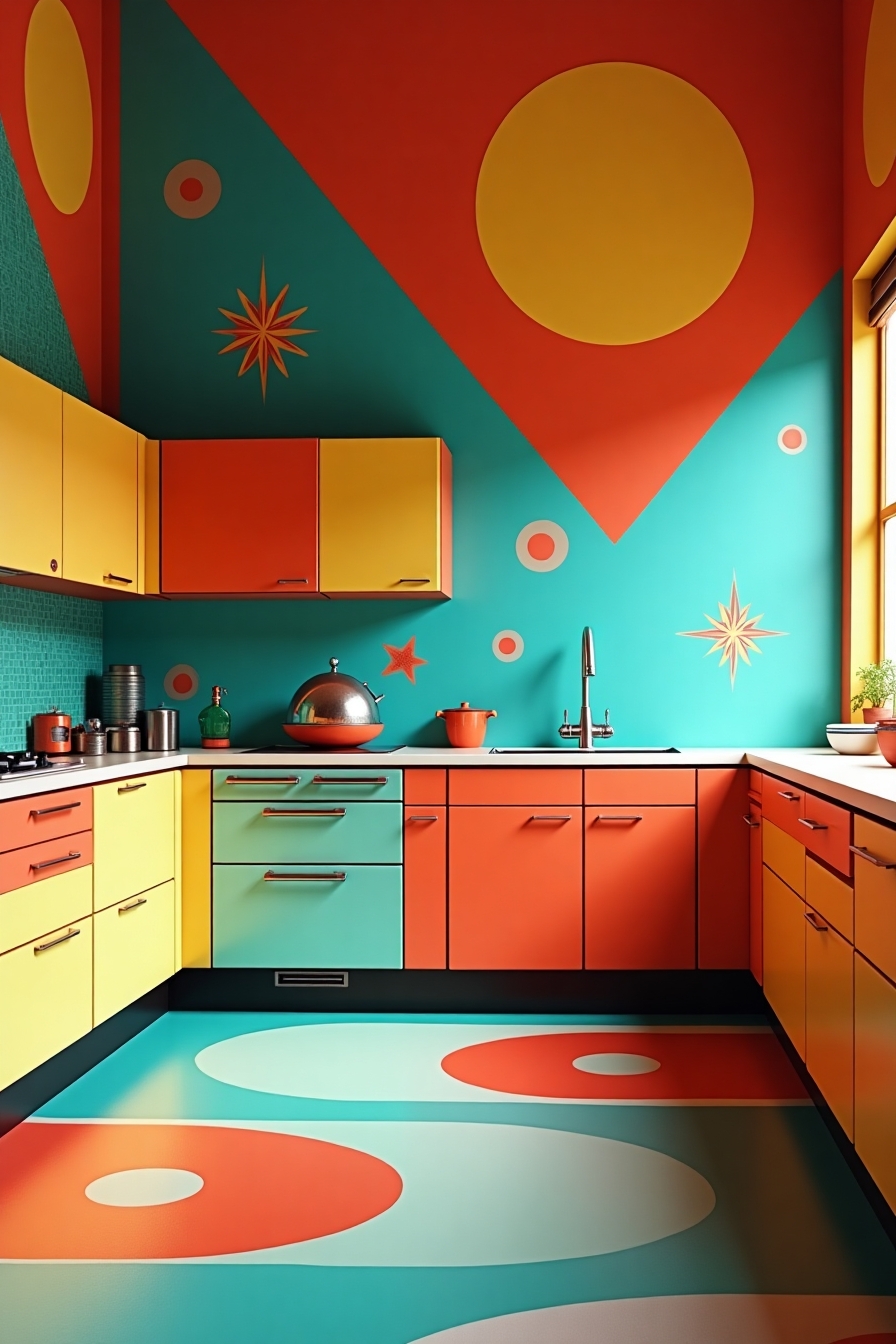Remember when kitchens weren’t just kitchens, but the heart of American optimism?
The 1950s kitchen wasn’t just about cooking—it was where post-war prosperity met Space Age dreams, all wrapped in candy-colored appliances and shiny chrome.
These nostalgic designs are making a major comeback, and for good reason—they bring warmth, character, and a touch of whimsy that modern minimalist kitchens often lack.
Ready to step back in time without sacrificing modern convenience?
Here are top fabulous ways to infuse your kitchen with that unmistakable 1950s charm that’ll have everyone talking.
✨Click to Get My 101 FREE Designer Room Ideas
Pastel Paradise: The Soft Color Palette That Defined an Era
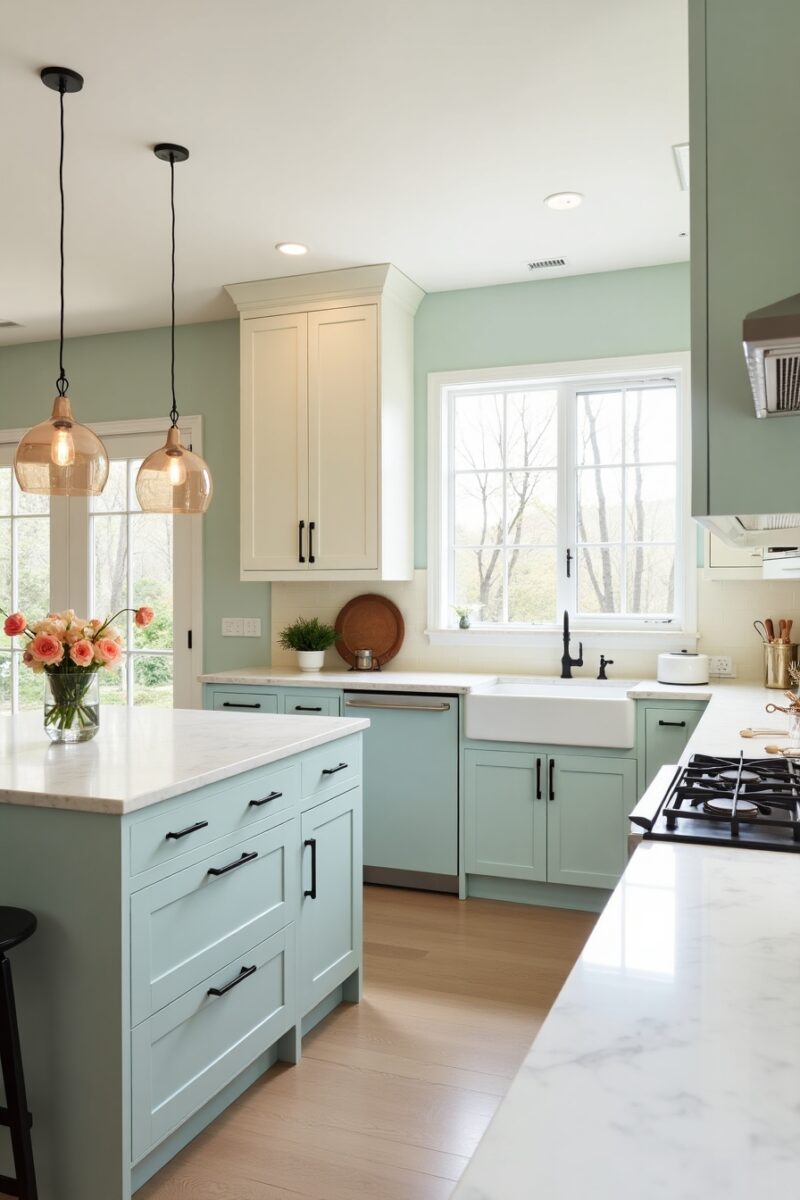

Nothing screams 1950s more instantly than those soft, dreamy pastel colors that brightened post-war America.
Think mint green refrigerators, baby blue countertops, butter yellow cabinets, and soft pink walls—colors that somehow managed to be both soothing and cheerful at once.
Incorporating these candy-colored hues doesn’t mean your kitchen has to look like an Easter egg hunt gone wild.
You can start small with pastel appliances like a mint green stand mixer or robin’s egg blue toaster that add just a touch of retro charm.
For a bigger commitment, consider painting your kitchen cabinets in a classic 50s shade like turquoise or pale yellow, instantly transforming your space with authentic period color.
The beauty of pastels is how they play with the abundant natural light that 50s kitchens were designed to maximize—reflecting brightness while creating a soft, welcoming glow.
Combine different pastel shades for the full effect, like pairing mint lower cabinets with white uppers and pink accessories for a balanced look that isn’t overwhelming.
Don’t forget that these colors aren’t just pretty—they were chosen during a time when homemakers spent countless hours in their kitchens, so they’re psychologically soothing colors that stand the test of time.
If you’re worried about resale value, keep your pastel choices to elements that can be easily changed, like paint, small appliances, or even removable wallpaper in classic 50s patterns.
These gentle hues contrast beautifully with the era’s signature chrome and black accents, creating that perfect balance of soft and sharp that made 50s kitchens so distinctive.
The 50s pastel palette works surprisingly well with natural elements like wooden cutting boards and pottery, creating a kitchen that feels both nostalgic and refreshingly contemporary.
For the most authentic look, research actual 1950s color combinations from old magazines or restoration websites to discover historically accurate pairings that have stood the test of time.
Remember that while we often think primarily of mint green and pink, the 50s palette also included seafoam, canary yellow, powder blue, and even soft coral—giving you plenty of options to find your perfect retro color scheme.
Checkerboard Charm: The Floor Pattern That Never Goes Out of Style
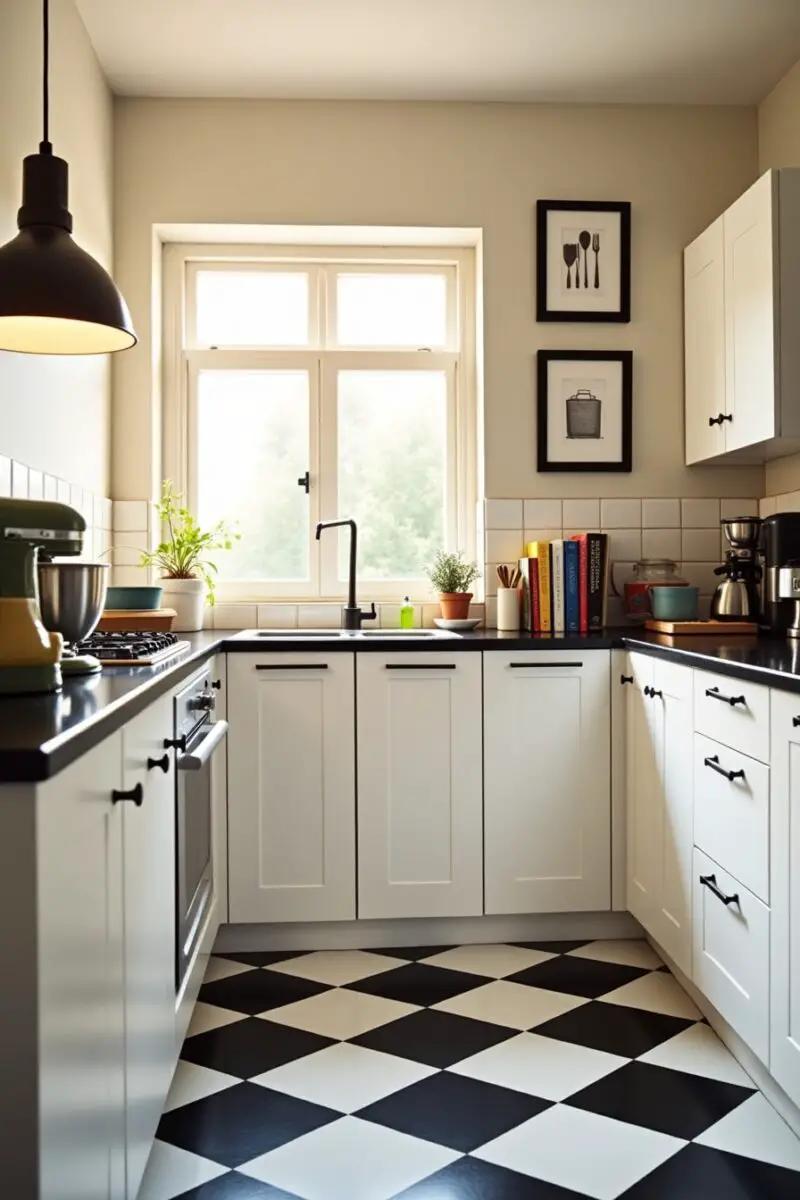
The black and white checkerboard floor might be the single most recognizable element of a classic 1950s kitchen.
This bold pattern instantly transports you back to sock hops and soda fountains, creating a foundation that screams mid-century Americana.
What made this flooring pattern so popular wasn’t just its striking appearance, but its practical nature—the high-contrast pattern expertly hid scuffs and marks in high-traffic kitchen areas.
Today’s versions come in easy-to-install vinyl tiles that give you the look without the maintenance headaches of the original materials.
You can play with scale too—while the classic 12×12 inch squares were common, larger or smaller checks can help you adapt the pattern to your kitchen’s proportions.
For a subtle twist on the classic, consider cream and black, gray and white, or even two different pastel colors for a softer take on this iconic pattern.
The beauty of checkerboard is how it anchors other 50s elements—it’s the perfect foundation for everything from chrome dinettes to candy-colored appliances.
Don’t restrict this pattern just to floors—checkerboard backsplashes, table tops, or even ceiling treatments can bring that distinctive mid-century vibe to any kitchen.
If committing to a full checkerboard floor feels overwhelming, try a checkerboard rug under your dining area or a smaller pattern in just one section of your kitchen.
Historical kitchens often featured checkerboard linoleum, but today’s porcelain, ceramic, or luxury vinyl options offer greater durability while maintaining that authentic look.
The pattern creates an optical illusion that can actually make small kitchens appear larger—one of the many reasons it worked so well in modest post-war homes.
For extra authenticity, consider adding a thin line of black or colored border tiles around the perimeter, a common detail in original 1950s installations.
The neutral nature of black and white means this pattern pairs beautifully with any color scheme, allowing you to change your kitchen’s look over time without replacing your floor.
Cleaning is remarkably simple—another reason this pattern has endured—with modern sealants making maintenance even easier than it was for your grandmother.
Chrome and Formica Fantasy: The Dynamic Duo of Diner Style

Nothing captures the futuristic optimism of the 1950s quite like the gleaming combination of chrome and Formica.
These materials represented the height of modern technology and design, bringing the sleek aesthetic of diners and soda fountains right into the American home.
The classic chrome-trimmed table with matching chairs upholstered in vibrant vinyl instantly creates a retro focal point in any kitchen, becoming both functional furniture and conversation piece.
Original vintage sets from the era can be found through specialty dealers and antique shops, often at surprising reasonable prices compared to new reproduction pieces.
If authenticity is your goal, look for tables with Formica tops in boomerang or cracked ice patterns—these iconic 50s designs are immediately recognizable symbols of the atomic age.
The durability of these materials explains why so many original pieces have survived—chrome resists corrosion while Formica stands up to decades of spills, heat, and daily use.
Modern reproductions capture all the style with improved materials, offering chrome that won’t pit and Formica that resists scratches better than the originals ever could.
Beyond the classic dinette set, consider chrome accents in light fixtures, cabinet hardware, and appliance trim to carry the metallic theme throughout your kitchen.
The reflective qualities of chrome served a practical purpose in smaller 1950s kitchens, bouncing light around the room to make spaces feel larger and more open.
Formica isn’t just for tabletops—consider this versatile material for countertops, backsplashes, or even cabinet facing for an authentically retro look that’s remarkably practical.
Color combinations were bold in the 50s—red and white, turquoise and chrome, yellow and gray—don’t be afraid to embrace these dramatic pairings for true period style.
For a unified look, match your vinyl chair upholstery to your wall color or accessories, creating the coordinated look that 1950s homemakers prized.
The beauty of chrome is its neutrality—this silver finish complements any color scheme, allowing you to change your kitchen’s palette without replacing your furniture.
Care is simple—modern chrome polishes restore shine in minutes, while Formica needs nothing more than regular wiping with a mild cleanser to maintain its luster for decades.
Retro Appliances: Modern Technology in Fabulous Fifties Packaging
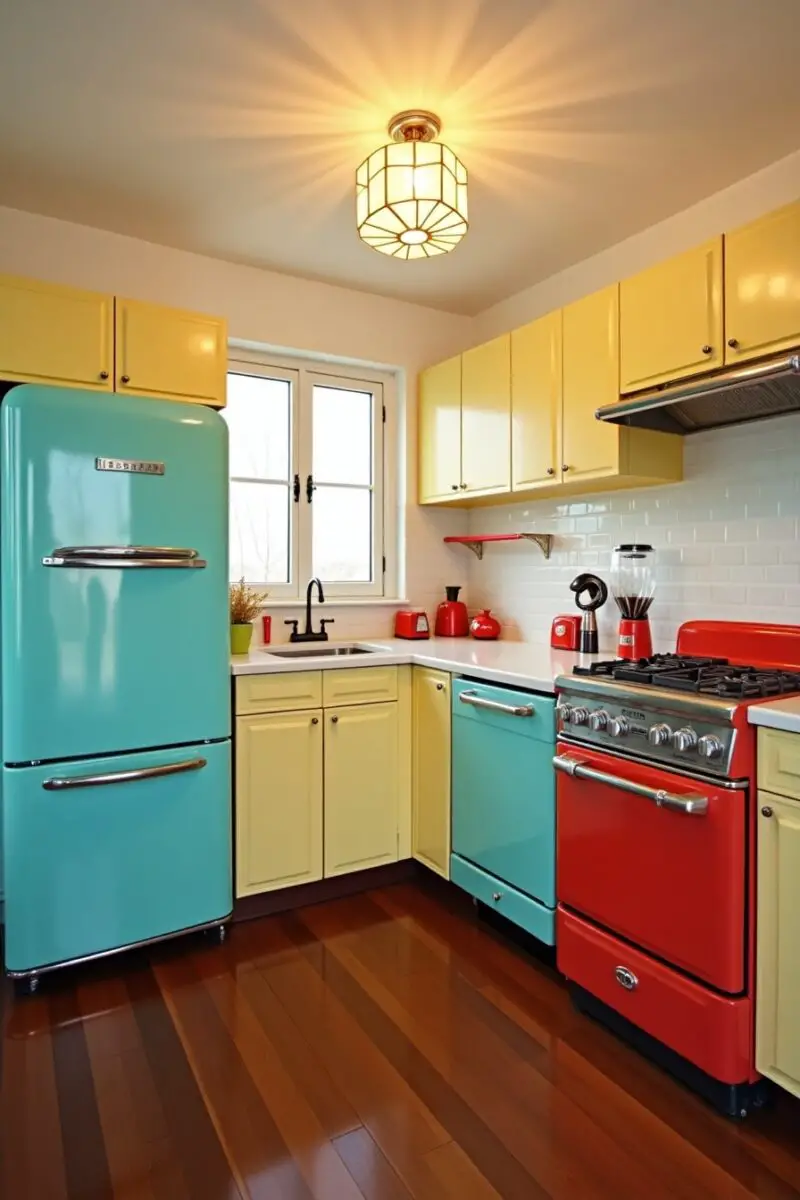
The colorful, rounded appliances of the 1950s weren’t just kitchen tools—they were status symbols representing America’s manufacturing might and technological innovation.
Today’s retro-style appliances offer the best of both worlds: authentic mid-century aesthetics with modern energy efficiency and convenient features our grandmothers could only dream about.
The refrigerator serves as the centerpiece of any 1950s kitchen remodel, with brands like Big Chill, Smeg, and Elmira Stoveworks offering perfect reproductions of those iconic rounded-corner models in a rainbow of period-perfect colors.
Unlike the originals that required manual defrosting, today’s retro fridges offer frost-free operation, water dispensers, and even smart technology hidden behind those charming chrome handles and badge-style logos.
Stoves with chrome accents, rounded edges, and chunky temperature dials bring serious vintage vibes while concealing modern conveniences like self-cleaning functions and precision temperature control.
Don’t overlook smaller appliances—a pastel stand mixer, chrome toaster, or vintage-style blender adds authentic touches without the commitment of larger appliances.
The rounded, streamlined shapes of 1950s appliances were influenced by the era’s fascination with aerodynamics and space exploration—design elements that still feel both nostalgic and futuristic today.
For budget-conscious renovators, appliance wraps and DIY painting kits can transform ordinary white appliances into colorful retro showpieces at a fraction of the cost.
Original vintage appliances can sometimes be restored to working condition, though be prepared for less energy efficiency and the potential need for specialized repair services.
The joyful colors of 50s appliances—candy pink, turquoise, buttercup yellow, mint green—were a direct reaction to the utilitarian, industrial aesthetic of war-time America, bringing optimism and playfulness into the domestic sphere.
Pay attention to details like chrome trim, distinctive handles, analog clocks, and rounded corners—these small elements make all the difference in achieving an authentic vintage look.
Many modern retro appliances offer customizable options, allowing you to mix and match colors or add personalized touches like custom badges or special handles.
For true authenticity, look beyond just the refrigerator and stove to period-appropriate range hoods, exhaust fans, and even retro-style dishwashers that disappear behind matching cabinet panels.
The investment in quality retro appliances often pays off in both durability and timeless appeal—these statement pieces rarely go out of style the way more trendy modern designs might.
✨Click to Get My 101 FREE Designer Room Ideas
Boomerang Patterns and Atomic Designs: The Signature Prints of the Space Age

The distinctive patterns of the 1950s weren’t just decorative choices—they reflected America’s obsession with scientific progress, atomic energy, and space exploration.
Boomerang patterns (sometimes called “amoeba” or “biomorphic” designs) featured abstract, curved shapes that resembled everything from kidney beans to the trajectory of space rockets.
These whimsical patterns adorned everything from Formica countertops to wallpaper, curtains, and upholstery, creating the unmistakable visual language of mid-century design.
The atomic starburst—with its radiating points reminiscent of an atom’s electron paths—became perhaps the most iconic motif, appearing on clocks, dishes, textiles, and architectural elements.
Incorporating these distinctive patterns doesn’t require a complete kitchen overhaul—start with wallpaper on a single accent wall or fabric for window treatments.
For a subtle approach, consider dishware with atomic patterns that can be displayed on open shelving, instantly communicating mid-century style without permanent commitment.
The beauty of these designs lies in their versatility—they work equally well in small doses (like a framed section of vintage wallpaper) or as bold statements (like a full boomerang-patterned counter).
Color was crucial to these patterns, typically featuring combinations like turquoise and black, pink and gray, or harvest gold and brown that immediately signal the 1950s aesthetic.
Modern interpretations of these classic patterns are widely available, from reproduction Formica in authentic boomerang patterns to contemporary fabrics that capture the atomic age spirit.
The abstract nature of these designs made them surprisingly timeless—unlike more figurative patterns, they don’t look obviously dated and continue to feel fresh and energetic decades later.
For kitchen counters, companies like Wilsonart and Formica have reissued classic 50s patterns in updated materials that resist staining and scratching better than the originals.
The geometric precision of atomic starbursts offers a pleasing contrast to the organic, flowing lines of boomerang patterns when used together in the same space.
These distinctive patterns pair beautifully with solid colored appliances and chrome accents, creating the perfect balance of visual interest without overwhelming the space.
Don’t overlook floors as a canvas for atomic-age patterns—vinyl floor tiles in boomerang or starburst designs make a bold statement while standing up to kitchen traffic.
Open Shelving Showcase: Displaying Vintage Kitchenware as Functional Art
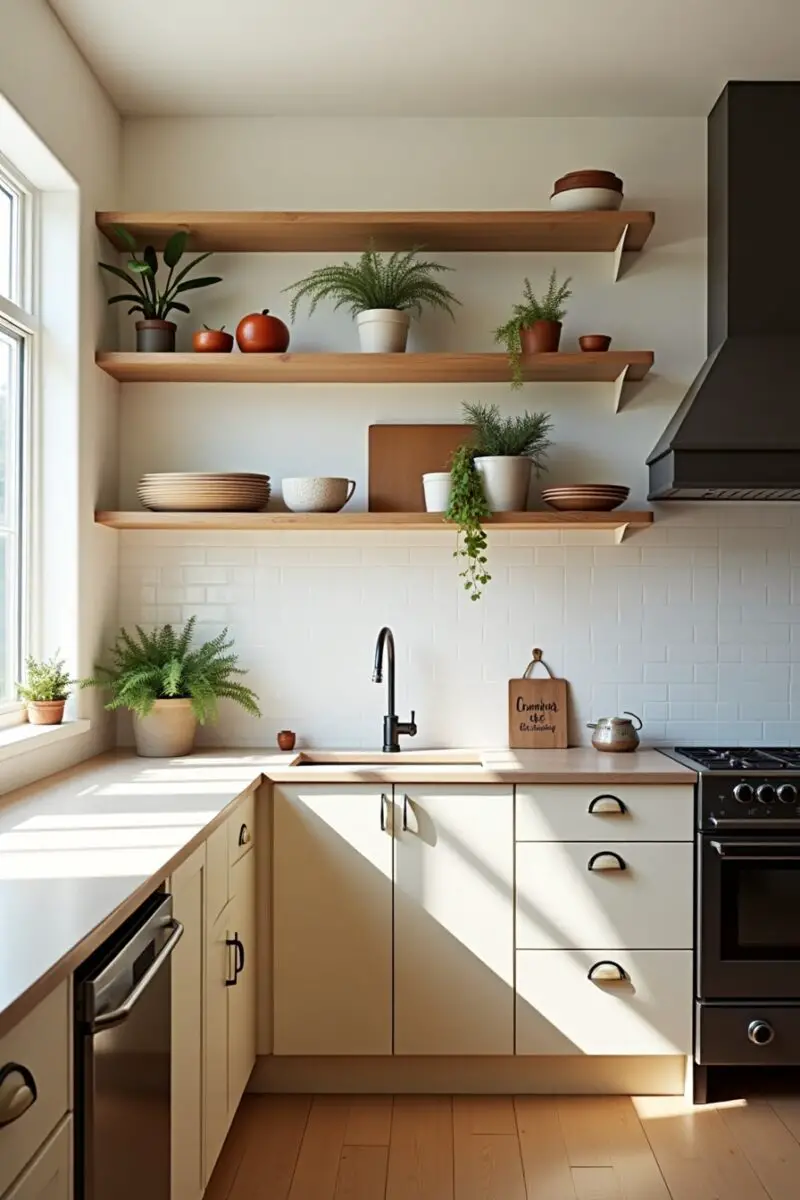
The 1950s homemaker took immense pride in her kitchen equipment, often displaying colorful dishes and gadgets rather than hiding them behind cabinet doors.
Open shelving wasn’t just practical—it was a way to showcase the newest Pyrex, Fiestaware, and colorful kitchen gadgets that represented prosperity and modern living.
Today, this approach offers the perfect opportunity to display vintage treasures while creating an authentic 50s look that’s both functional and decorative.
Colorful Pyrex mixing bowls and refrigerator dishes in patterns like “Butterprint,” “Gooseberry,” and “Pink Daisy” instantly communicate 1950s style, whether you find original pieces or modern reproductions.
Fiestaware’s bold, solid colors were staples in mid-century kitchens, with vintage pieces in colors like medium green, rose, and gray being particularly prized by collectors today.
Glass shelves with chrome brackets provide the most authentic 50s look, allowing light to pass through while providing sturdy support for your vintage dishware collection.
The beauty of open shelving lies in its flexibility—you can rotate seasonal colors, change displays based on holidays, or gradually add pieces as you find them without major renovations.
Melamine dishes in colorful patterns were revolutionary in the 1950s, offering practically unbreakable dinnerware in fashion-forward colors and patterns that still look fresh today.
Don’t overlook authentic kitchen gadgets—chrome juicers, colorful hand mixers, and mechanical kitchen timers add authentic touches while remaining completely functional.
Arranging pieces by color creates a striking rainbow effect that was popular in magazine spreads of the era, demonstrating both organization and artistic arrangement.
Jadeite glassware—that distinctive opaque green glass—was tremendously popular in the 1950s and makes a stunning display when grouped together on open shelving.
For a balanced look, consider open shelving for your decorative pieces while maintaining closed storage below for less display-worthy necessities.
Lighting is essential for showcasing your collection—consider under-shelf lighting strips to illuminate your vintage treasures and create ambient kitchen lighting.
The practical advantage of open shelving is accessibility—frequently used items are always within easy reach, just as 1950s kitchen designers intended when efficiency was paramount.
Breakfast Nook Bonanza: Cozy Built-In Dining That Maximizes Space


The breakfast nook might be the most charming innovation of 1950s kitchen design, carving out a designated dining area even in modest postwar homes.
These built-in spaces typically featured a U-shaped bench or L-shaped seating area tucked into a corner or positioned under a window to maximize natural light.
What made these spaces uniquely 50s was the combination of practicality and playfulness—storage drawers beneath bench seats, vinyl upholstery in bright colors, and often a pendant light hanging directly over the table.
Creating a breakfast nook today offers the same advantages it did in the 50s—efficient use of space, comfortable seating for more people than traditional chairs would allow, and a designated area that keeps dining separate from food preparation.
Vinyl upholstery in quintessential 50s colors like turquoise, red, or yellow brings authentic mid-century style while offering the practical advantage of easy cleaning—just like it did for busy homemakers seventy years ago.
The ideal table for a breakfast nook features a chrome pedestal base with a Formica top, preferably in a complementary color or pattern that coordinates with your bench upholstery.
Window placement is crucial for an authentic feel—many original breakfast nooks featured corner windows or bay windows that flooded the area with natural light while providing views of the backyard.
Built-in planters were a common feature in 50s breakfast nooks, offering a place to grow herbs or display small houseplants that added life and color to the kitchen.
Storage beneath bench seating wasn’t just convenient—it represented the efficient space usage that defined post-war home design when maximizing every square inch was essential.
For modern living, consider adding electrical outlets in your breakfast nook design for charging devices or plugging in small appliances when the space doubles as a homework station.
The intimacy of a breakfast nook encourages family meals and conversation, reinforcing the 1950s ideal of the kitchen as the heart of family togetherness.
Original 50s breakfast nooks often featured table edges banded in aluminum trim, a detail worth replicating for true period authenticity in your reproduction space.
The slightly enclosed feeling of a breakfast nook creates a psychological sense of coziness that open kitchen designs often lack, making meals feel more special and intentional.
If building a permanent breakfast nook isn’t feasible, consider a freestanding banquette with similar features—L-shaped seating, storage underneath, and positioned near a window for that authentic 50s feel.
Vintage-Inspired Lighting: Illuminating with Mid-Century Flair

Lighting in 1950s kitchens wasn’t just functional—it was an opportunity to incorporate sculptural, artistic elements that reflected the era’s forward-thinking design sensibilities.
The atomic starburst chandelier, with its radiating metal rods and multiple bulbs, has become perhaps the most iconic lighting fixture of the mid-century era, instantly recognizable as a symbol of 50s optimism.
Pendant lights with colorful cone-shaped shades in enameled metal brought focused task lighting to work areas while adding vibrant color to the kitchen’s upper spaces.
Glass globe fixtures—either singular pendants or clustered in chandelier form—offered soft, diffused light that eliminated harsh shadows while providing the smooth, rounded forms that characterized the era’s design.
Under-cabinet lighting wasn’t common in original 1950s kitchens, but adding modern LED strips provides practical illumination while remaining invisible, preserving the authentic period look.
Flush-mount ceiling fixtures with starbursts or atomic patterns in the glass diffusers brought style to smaller kitchens where pendant lights might have been impractical.
Chrome and brushed aluminum were the dominant metals for light fixtures, reflecting both the space-age aesthetic and the era’s fascination with new industrial materials.
Pull-down pendant lights above kitchen tables could be raised or lowered as needed, combining practical functionality with distinctive mid-century styling that remains sought-after today.
Tension pole lamps—those floor-to-ceiling poles with adjustable lights—were innovations of the 1950s that work beautifully in modern kitchens to provide ambient lighting in eating areas.
Colorful kitchen lighting wasn’t limited to the shades—even bulbs came in soft colors like pink and blue to create flattering light that made both food and people look their best.
Reproduction mid-century lighting has become widely available as demand has increased, offering authentic styles with updated wiring that meets modern safety standards.
For true authenticity, look for lighting fixtures with details like perforated metal shades, textured glass, and pull chains rather than wall switches—small elements that immediately signal 1950s design.
Positioning is key—in original 50s kitchens, lighting was carefully planned to illuminate work surfaces without creating glare, a principle worth following in your retro renovation.
The scale of 1950s lighting tends to be more modest than today’s oversized fixtures, so choose appropriately sized pieces that maintain proportion with your space for the most authentic look.
✨Click to Get My 101 FREE Designer Room Ideas
Classic Cabinet Configurations: Storage Solutions with Period-Perfect Style


Cabinet design underwent a revolution in the 1950s, shifting from freestanding furniture to the built-in, continuous runs of cabinetry that define modern kitchens.
The most distinctive feature of 1950s cabinets was their flat slab doors—a dramatic departure from earlier raised panel styles—often finished in light wood tones like birch or ash.
Steel cabinets enjoyed a brief but passionate heyday in the 1950s, with brands like Geneva and Youngstown producing modular kitchen systems in white or pastel colors with streamlined, easy-to-clean surfaces.
Upper cabinets typically stopped short of the ceiling, creating display space above for decorative items—a practical feature that also prevented kitchens from feeling closed-in or top-heavy.
Hardware made a statement in 50s kitchen design, with distinctive chrome pulls, often in elongated shapes with backplates that resembled boomerangs or atomic symbols.
Glass-front cabinets weren’t just decorative—they allowed homemakers to showcase their coordinated dishware collections while making it easy to locate needed items.
Corner cabinets often featured lazy Susan turntables, an innovation that made previously awkward storage spaces fully functional—a practical solution that remains valuable today.
The classic layout typically featured continuous countertops with built-in appliances, creating an efficient workflow that professional kitchen designers still follow with the traditional work triangle.
Mixing cabinet materials was common in stylish 50s kitchens—perhaps wood on the lowers with laminate or metal on the uppers—creating visual interest while defining different functional zones.
Soffit areas (the space between upper cabinets and the ceiling) were often painted in contrasting colors or covered with decorative materials like scalloped trim or patterned wallpaper.
Open shelving frequently appeared at the ends of cabinet runs or above countertops, providing both storage and display space for everyday items that added color to the kitchen.
Toe kicks (the recessed space at the bottom of lower cabinets) were often finished in black rubber or contrasting colors, a small detail that contributed to the distinctive 50s look.
Cabinet interiors featured specialized storage innovations like spice racks, bread drawers, pull-out cutting boards, and flour sifters built directly into the cabinetry.
The continuous backsplash that curved up from the counter and rounded over at the top edge was a signature 50s feature, creating a seamless, easy-to-clean surface that protected the wall.
Nostalgic Accessories: The Final Touches That Complete the Time Travel Experience

The magic of a truly authentic 1950s kitchen often lies in the carefully chosen accessories that tell the story of mid-century domestic life.
Starburst clocks with their radiating metal rays weren’t just timepieces—they were sculptural wall art that perfectly embodied the atomic age aesthetic.
Vintage kitchen timers in egg or flying saucer shapes brought whimsy to a practical tool, often in bright colors that coordinated with the kitchen’s overall color scheme.
Canister sets in graduated sizes lined countertops, typically in matching colors or patterns labeled with script lettering for flour, sugar, coffee, and tea.
Paper towel holders, often shaped like rocket ships or featuring atomic motifs, transformed an everyday item into a design statement that reinforced the futuristic kitchen theme.
Decorative copper molds shaped like fish, fruit, or geometric forms hung on walls as both practical cooking tools and artistic elements that caught the light.
Novelty salt and pepper shakers took the form of everything from vegetables to cartoon characters, adding playful touches that reflected the era’s optimistic spirit.
Transistor radios perched on windowsills, bringing music and news programs into the kitchen when household electronics were still new and exciting luxuries.
Hand-painted ceramic planters, often in the shape of animals or abstract forms, housed small kitchen herbs or decorative plants that added life to windowsills.
Advertising thermometers from food brands like Coca-Cola or dairy companies combined practical function with colorful graphics that now read as vintage art.
Refrigerator magnets weren’t common in the actual 1950s, but vintage-style reproduction magnets featuring period advertisements or sayings add authentic-looking charm to modern appliances.
Textiles played a crucial role—cheerful hand towels with day-of-the-week embroidery, pot holders in bright colors, and appliance covers sewn from coordinating fabrics.
Recipe card boxes kept favorite family dishes organized, often crafted in plastic with distinctive mid-century patterns or wooden boxes with decorative decals.
Cocktail accessories became kitchen staples during the 1950s, with martini shakers, ice buckets, and bar tools in chrome or anodized aluminum adding sophisticated touches to casual kitchens.
Mixing Old and New: Creating Your Perfect Retro Kitchen Paradise
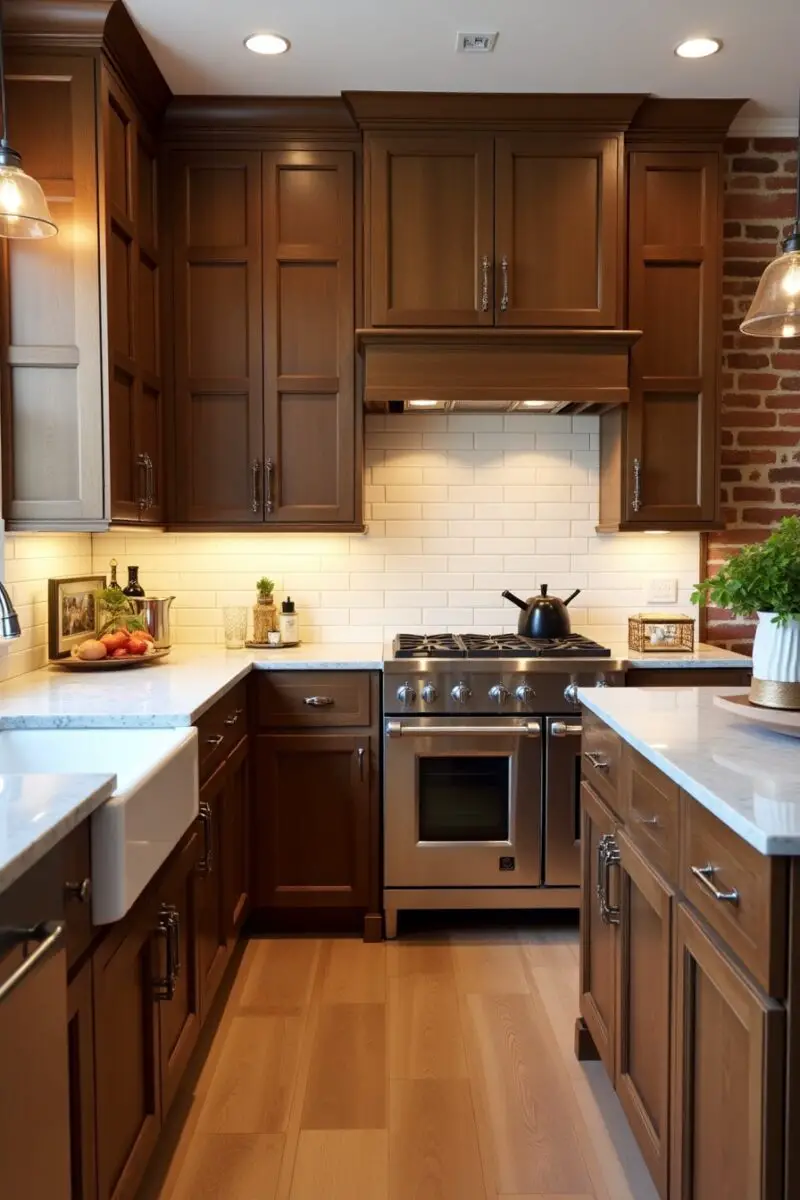
Bringing 1950s kitchen style into your home isn’t about creating a museum—it’s about capturing the optimistic, colorful spirit that made these spaces the heart of post-war American homes.
The best retro kitchens balance authentic vintage touches with modern conveniences, creating spaces that look nostalgic but function for today’s lifestyle.
The enduring popularity of 1950s kitchen design speaks to something deeply appealing about this era—perhaps it’s the unabashed embrace of color, the prioritization of family togetherness, or the optimistic vision of the future that these spaces embodied.
Whatever elements you choose to incorporate, you’re connecting with a uniquely American design language that continues to evoke joy, nostalgia, and that special sense of home that never goes out of style.

